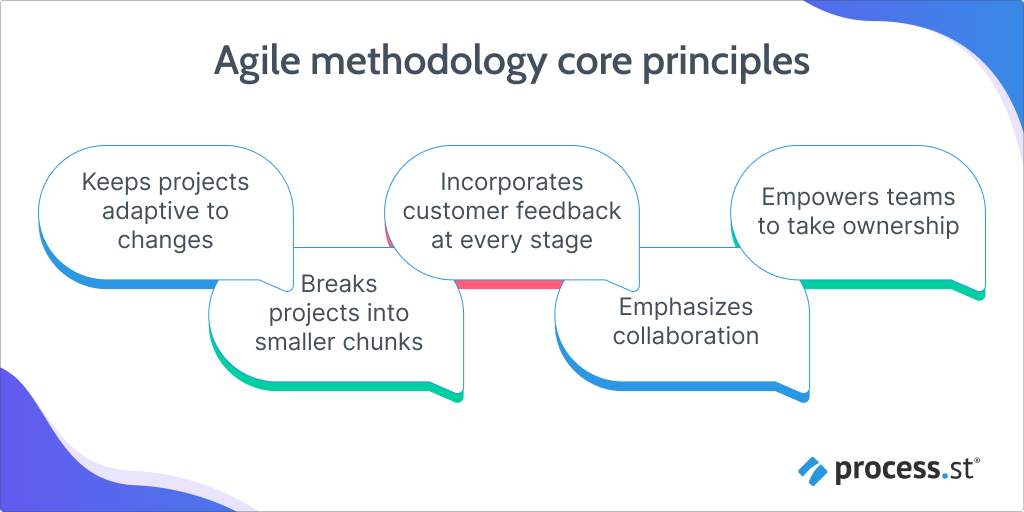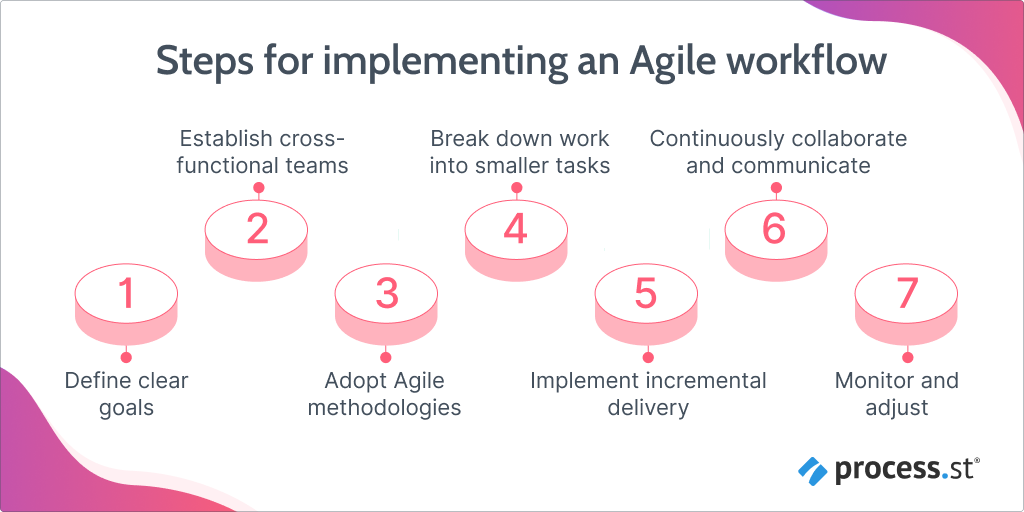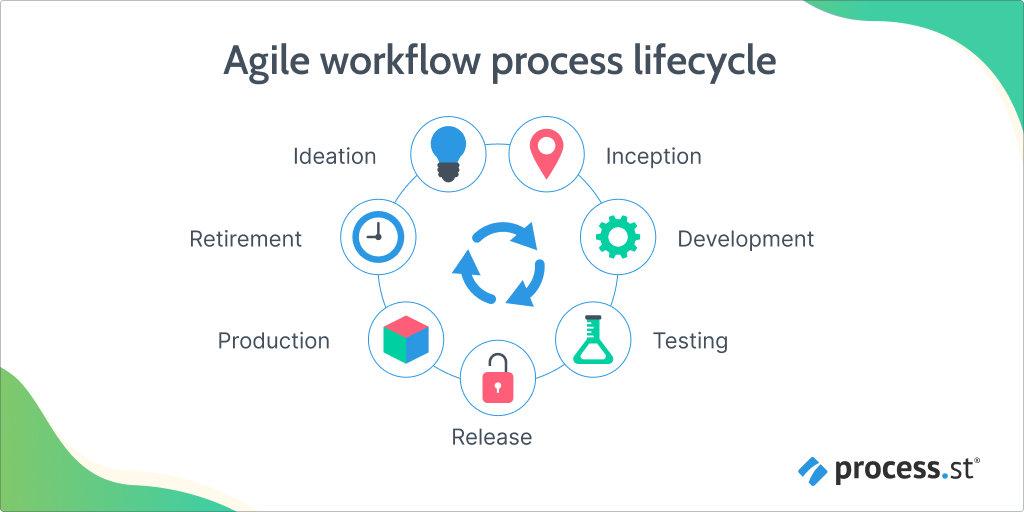Get started quickly, see results immediately, no code needed.
Agile Workflow Process: Everything You Need to Know
Understanding how an Agile workflow process functions is super important if you want to make it anywhere in the tech world since it’s pretty much the standard method of operation.
If you don’t understand it, fear not. I’m here to help you.
Consider this your crash course. And in this course, we will cover what an Agile workflow process is, how it compares to a traditional workflow, its benefits, and its lifecycle.
Basically everything you could possibly need to help you get started.
Let’s go!
What is an Agile workflow process?
An Agile workflow process is a way of managing and executing projects that emphasizes flexibility, collaboration, and continual improvement using the Agile method.
Unlike traditional workflow models that follow a linear and rigid approach, an Agile workflow process allows for iterative development and adaptation based on customer feedback and changing requirements.
At the core of an Agile workflow process is the concept of Agile methodologies, which include Scrum, Kanban, and Lean, among others. These methodologies provide a framework for managing projects through short development cycles, known as sprints or iterations.
In an Agile workflow process, project teams are self-organizing, cross-functional, and empowered to make decisions. This promotes effective team collaboration and eliminates the need for a traditional project manager.
Instead, the team as a whole takes ownership of the project, which results in increased motivation and accountability.
The workflow begins with a product backlog, which is a prioritized list of items or features that need to be developed.
These items are further broken down into user stories, which describe the specific needs and expectations of the end-users. During the sprint planning phase, the team selects a set of user stories to work on during the sprint.
Throughout the sprint, the team follows the agile principles of continuous improvement and customer feedback. Daily stand-up meetings ensure that team members are aligned, obstacles are identified, and progress is monitored.
At the end of the sprint, a sprint review is conducted to gather feedback from stakeholders and assess whether the goals were achieved.
One of the key benefits of an Agile workflow process is the increased focus on delivering a viable product incrementally. This approach allows for quicker testing, validation, and adaptation, resulting in the development of high-quality products that meet customer needs effectively.
The basics of Agile methodology
The basics of the Agile approach lie in its ability to keep projects flexible, adaptive, and responsive to changes. Agile methodology is a set of principles and practices that emphasize collaboration, iterative development, and delivering value to the customer.
One of the core principles of Agile is the concept of short development cycles called sprints or iterations. Unlike traditional Waterfall methods, where all requirements are defined upfront, Agile breaks the project into smaller, manageable chunks.
This allows sprint teams to work on small deliverables that can be tested, validated, and adapted based on customer feedback.
Agile methodologies such as Scrum, Kanban, and Lean provide a framework for implementing Agile principles.
Scrum, for example, divides work into time-boxed iterations known as sprints. During each sprint, the team selects a set of features or user stories to work on. The team then collaborates daily in daily stand-up meetings to monitor progress, identify obstacles, and ensure alignment.
Another important aspect of Agile methodology is the concept of self-organizing and cross-functional teams. In Agile, there is no traditional project manager dictating the tasks and responsibilities. Instead, the entire team is empowered to make decisions and take ownership of the project. They are all product owners in a sense.
This promotes effective team collaboration, improves motivation and accountability, and encourages everyone to contribute their skills and expertise.
Lastly, customer satisfaction is at the heart of Agile methodology. The iterative development approach allows for regular feedback from stakeholders and end-users, ensuring that their needs and expectations are continuously met.
By incorporating customer feedback throughout the development process, Agile teams can make necessary adjustments and deliver a product that truly aligns with customer requirements.

Agile workflow process benefits
So what kind of benefits does this increased agility bring to an organization? Let’s break it down.
More collaboration
Because the Agile workflow process doesn’t follow a rigid structure, teams need some kind of way to track their progress.
Some types of Agile workflow processes offer visualization boards where team members, managers, and even customers can see who is working on what and at what stage the workflow is currently in. This gets everyone on the same page, which makes collaborating become easier.
Happier customers
As we discussed, customer feedback is a major part of the Agile workflow process. In fact, customers are involved in every stage of the process from the very beginning.
This means that anything developed using the Agile methodology is considering the needs of the customer from the very beginning. Teams have a better understanding of what the customer wants, how easily the customer can use the products, everything.
So by the time the product hits the market, it’s the most customer-friendly it can be.
Better adaptability
With an Agile workflow process, you’re not locked into place waiting for someone to finish their work so you can start yours. You’re also not locked into a predetermined plan for the process.
You have the freedom to work simultaneously on different parts of the process and change the overall plan whenever deemed necessary. And at the speed with which tech is constantly changing, that level of adaptability is essential for a business’s survival.
Faster to market
Everything mentioned above leads to this last benefit. With more collaboration, consistent customer feedback, and better adaptability, your team will be able to get your product/service/updates/whatever to market so much faster.
By having the ability to break a large workflow process down into smaller sprints that teams can work on simultaneously, you cut out a lot of downtime and increase efficiency by a lot.
Building an effective Agile team
An integral part of Agile success lies in building an effective Agile team that can deliver high-quality products and drive successful project outcomes. So, how can organizations go about assembling and nurturing such a team? Allow me lay it all out for you.
Embrace a cross-functional and self-organizing approach
An effective Agile team comprises individuals with diverse skills and expertise who can collaborate seamlessly to achieve project goals. By bringing together professionals from different disciplines, such as development, quality assurance, design, and product management, a cross-functional team can leverage each member’s unique perspective to deliver better results.
Additionally, empowering the team to self-organize allows for better decision-making and a greater sense of ownership over the project.
Foster clear communication and collaboration
Open and transparent communication is crucial for Agile teams to succeed. Encourage team members to share ideas, concerns, and progress updates regularly.
Daily stand-up meetings can facilitate effective communication and alignment by allowing team members to discuss their tasks, dependencies, and any challenges they may be facing.
Collaboration tools, such as project management software and virtual workspaces, can also help streamline communication and ensure everyone is on the same page.
Prioritize continuous learning and improvement
Agile methodologies promote a culture of continuous improvement, where teams reflect on their processes and behaviors to identify areas for enhancement.
Encourage regular retrospectives where team members can openly discuss successes, challenges, and potential improvements. Act upon the lessons learned in these sessions to refine workflows, optimize productivity, and deliver even higher-quality products.
Encourage flexibility and adaptability
Agile teams must be flexible and adaptable to respond to changing requirements and market conditions. Encourage team members to embrace uncertainty and be open to adjusting plans and priorities as needed.
Agile methodologies like Scrum, allocate time-bound iterations called sprints, allowing for regular review and adaptation of project goals. This iterative approach empowers teams to remain nimble and deliver incremental value throughout the project lifecycle.
Promote a culture of trust and psychological safety
Trust and psychological safety are essential foundations for effective collaboration within Agile teams. Foster an environment where team members feel comfortable taking risks, expressing opinions, and providing constructive feedback.
Encourage a blame-free culture where mistakes are viewed as learning opportunities and where individuals feel supported in their personal and professional growth.
Implementing the processes for an Agile workflow
When it comes to implementing an Agile approach to your workflows, organizations need to go beyond theoretical frameworks and put their plans into action.
It takes careful planning, clear communication, and a commitment to continuous improvement to successfully execute an Agile workflow. Here are some key steps to consider when implementing the processes for an Agile workflow.

Define clear goals and objectives
Before starting any agile project, it’s crucial to define clear goals and objectives. This will provide a roadmap for the entire team and ensure that everyone is aligned from the start. By setting these goals, teams can focus their efforts on delivering specific outcomes and prioritize their tasks accordingly.
Establish cross-functional teams
The success of an Agile workflow lies in the collaboration between different functional areas. By establishing cross-functional teams, organizations can ensure that individuals with diverse skills and expertise are working together towards a common goal. This approach promotes knowledge sharing, breaks down functional silos, and fosters a sense of collective ownership.
Adopt Agile methodologies
There are various Agile methodologies and frameworks available, such as Scrum, Kanban, and Lean, each with its own unique processes and practices. It’s important to select the methodology that best suits the organization’s needs and goals.
Once chosen, the team should thoroughly understand and implement the chosen methodology, including ceremonies and artifacts, to ensure a smooth workflow.
Break down work into user stories and tasks
In Agile, work is broken down into user stories, which represent specific functionalities or features from the user’s perspective.
User stories are then further broken down into tasks, which are small and achievable units of work. By breaking the work down in this manner, teams can easily prioritize, estimate, and track progress, enabling them to deliver value in shorter iterations or sprints.
Implement iterative and incremental delivery
Agile workflows focus on delivering value in small, manageable increments rather than waiting until the end for a big reveal.
This iterative and incremental approach allows for faster feedback, better adaptability to change, and more frequent customer involvement. By delivering usable features or functionalities at the end of each iteration, teams can continuously receive feedback and make improvements.
Ensure continuous collaboration and communication
Effective collaboration and communication are critical to the success of an Agile workflow. Daily stand-up meetings, sprint planning sessions, and retrospective meetings facilitate transparency, keep everyone informed of progress, and identify any obstacles.
Ongoing communication ensures that team members are working towards a shared vision and can promptly address any issues that arise.
Monitor and adjust
An Agile workflow is a dynamic process that requires constant monitoring and adjustment. Regularly review key performance indicators, such as sprint velocity or cycle time, to assess the team’s performance and make data-driven decisions.
This feedback loop helps the team identify bottlenecks, areas for improvement, and make necessary adjustments to optimize productivity and quality.
The Agile workflow process lifecycle
Alright, let’s take a look at what the Agile process lifecycle actually looks like.

Ideation
When putting together an Agile workflow process, the first step is to make a plan. Although the plan isn’t as definite as what would be needed for the Waterfall method, it still has to give some kind of direction.
Ideation in an Agile workflow process needs to define the scope of the workflow, while also giving teams time to create a product backlog. It’s also vital to outline the project sprints during this stage.
Inception
Once you get the workflow verified and approved, the next step is to assemble all the resources necessary to get it done.
The biggest thing is to organize cross-functional teams. Work with them to set goals and create a timeline before assigning tasks. This is also the time to assess the resources your teams need, which could include:
- Funding
- Additional support
- Tools
- Snacks
Development
Now that you’ve got all your ducks in a row, you can let them swim. This is the stage where everyone starts working on what they’ve been assigned.
One of the most important parts of this stage is documentation. Your teams should be documenting everything they work on by using a tool like business process management software so it’s all kept in the same place.
Testing
This is arguably the most crucial part of the Agile workflow process lifecycle.
Before you release anything to market, you need to test it. And then test it again. And then test it one more time for luck. This is where your customer and team feedback is most useful because it will be able to pick up on any problems with the product early. Never skip testing or I’ll come find you and make you do it.
Release
You did it! Let it fly! Feel the rain on your skin! No one else can feel it for you!
Oh no, is my inner millennial showing?
After you’ve completed a few successful tests, you’re ready to release your product. How exciting! But it’s important to understand that releasing the product is not where the lifecycle ends.
Production
This stage is all about training customers and other end users and providing them with ongoing support.
Remember, with Agile, you are never done receiving feedback. It’s inevitable that your product will get bugs or need updates down the line, so keep your ear to the ground and always make sure you address customer needs.
Retirement
If the release of your new product makes an old one redundant, you can retire it. When a product is retired, it’s the official end of the lifecycle.
Before you go
Agile workflow processes are insanely useful in the development of new tech products. If you’re interested in trying out a business process management tool to help you get started with Agile, you can book a demo with Process Street and we’ll show you how our product will help.







